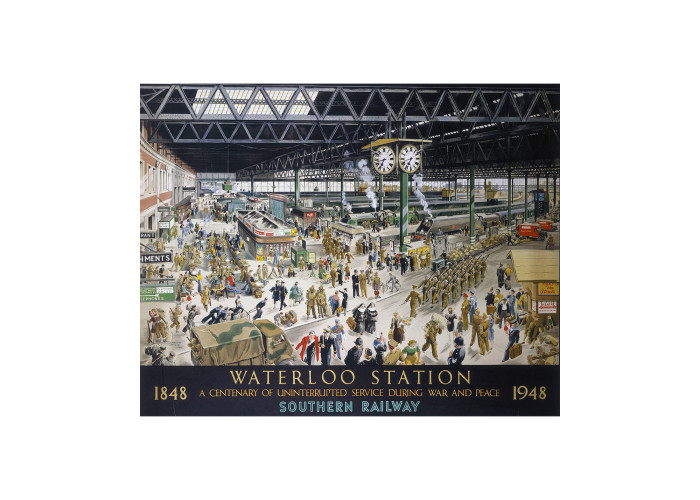Waterloo Station Poster
This poster of Waterloo Station was drawn by the artist Helen McKie for the railway station’s 100th anniversary in 1947. It is a charming demonstration of how the memory of Waterloo still remains in place names and in our common culture.
Waterloo Station, designed by the architect Sir William Tite (1798-1873) for the London and South Western Railway, was Victorian London’s fourth railway terminus. It opened in July 1848 as Waterloo Bridge Station, named after the nearby Thames crossing. It was soon became commonly known as ‘Waterloo Station’, and in 1886 this became its official name.
Helen McKie’s colour lithograph was executed in 1947, and printed as a poster the following year to mark the centenary of the station. It was a companion piece to her 1943 illustration ‘Waterloo Station – War’. In the earlier work, the platoon of soldiers is wearing khaki, while in the later one the men are in celebratory military dress and a piper is playing. In both versions, two nuns cross in front of the soldiers.
McKie (1889-1957) was a graphic illustrator who became known for her military illustrations. Her commissions for Southern Railway include a 1940 watercolour of one of the station’s roof spotters and another, ‘Belgium Nuns in the Blackout at Waterloo’.
The poster’s slogan, ‘A Century of Uninterrupted Service During Peace and War’, alludes to the station’s strategic importance for London in wartime. In her work, Waterloo Station becomes a microcosm of London and the nation. During the wartime exertions of the 1940s, it was the scene of another battle of Waterloo. The fact that it endured despite its main concourse having been bombed in 1942 was in itself a cause for celebration.
-
Curatorial info
- Originating Museum: Science Museum Group
- Accession Number: 1975-8527
- Production Date: 1948
- Material: Watercolour on canvas
- Technique: Watercolour
-
Use this image
You can download and use the high resolution image under a Creative Commons licence, for all non-commercial purposes, provided you attribute the copyright holder.
- Rights Holder: Science Museum Group / National Railway Museum
- License Type: All Rights Reserved
Find it here
This object is in the collection of National Railway Museum










